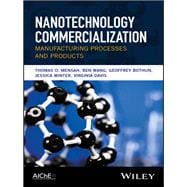A fascinating and informative look at state-of-the-art nanotechnology research, worldwide, and its vast commercial potential
Nanotechnology Commercialization: Manufacturing Processes and Products presents a detailed look at the state of the art in nanotechnology and explores key issues that must still be addressed in order to successfully commercialize that vital technology. Written by a team of distinguished experts in the field, it covers a range of applications notably: military, space, and commercial transport applications, as well as applications for missiles, aircraft, aerospace, and commercial transport systems.
The drive to advance the frontiers of nanotechnology has become a major global initiative with profound economic, military, and environmental implications. Nanotechnology has tremendous commercial and economic implications with a projected $ 1.2 trillion-dollar global market. This book describes current research in the field and details its commercial potential—from work bench to market.
- Examines the state of the art in nanotechnology and explores key issues surrounding its commercialization
- Takes a real-world approach, with chapters written from a practical viewpoint, detailing the latest research and considering its potential commercial and defense applications
- Presents the current research and proposed applications of nanotechnology in such a way as to stimulate further research and development of new applications
- Written by an all-star team of experts, including pioneer patent-holders and award-winning researchers in nanotechnology
The major challenge currently faced by researchers in nanotechnology is successfully transitioning laboratory research into viable commercial products for the 21st century. Written for professionals across an array of research and engineering disciplines, Nanotechnology Commercialization: Manufacturing Processes and Products does much to help them bridge the gap between lab and marketplace.








